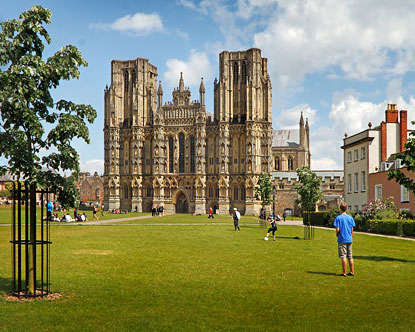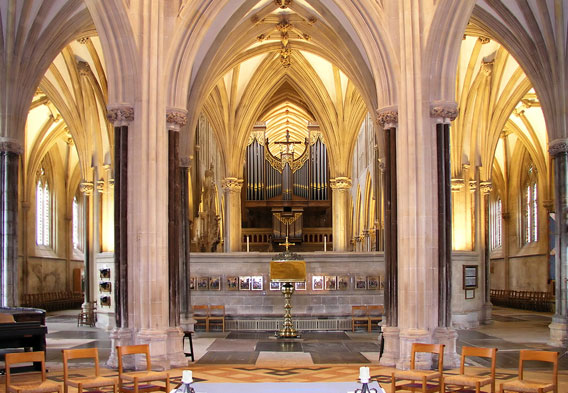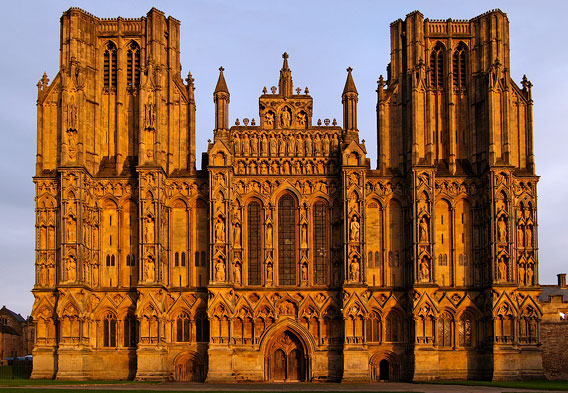Wells Cathedral

Wells Cathedral was once described by renowned English architectural historian, Alec Clifton-Taylor, as “the most poetic of the English Cathedrals.” Situated within an easy drive from major cities such as Bristol and Cardiff, the capital of Wales, this majestic monument of architecture makes an excellent addition to any journey to Great Britain. For even more architectural indulgence, continue 23 miles northeast to the picturesque town of Bath.
History

This area around Wells Cathedral is thought to have originally been settled due to its springs of running water, still present in the gardens of the Bishop’s Palace. Uncovered artifacts from the Stone Age, Romans, and Saxons speak of a rich history. The existing cathedral was built between 1175 and 1490, a time when Gothic style architecture was unheard of in England. Wells was the first cathedral to be built in this ornamented, French style.
The first building was completed after 80 years of construction, soon followed by the Chapter House, and the Cloisters. Work then began on expanding the primary cathedral by a third of its original size, adding height to the towers and length to the quire. The Lady Chapel was also built. By the middle of the 14th century, work had begun on the Vicars’ Close.
While Wells Cathedral survived England’s destructive Reformation with only a whitewash of painted images, it endured more substantial destruction in the century to follow. During these years, the cathedral was used as a stable and a prison, and part of the West Window was destroyed by the Great Storm of 1703. During the Victorian era, architect Anthony Salvin began a great restoration project on Wells Cathedral, called “The Great Scrape.” Since then, Wells Cathedral has been maintained by consistent restoration and conservation efforts.
Architecture

The majority of Wells Cathedral is built in Early English Gothic style, most noticeably emphasized by its vaulted nave ceiling, pointed arches, and exterior front façade. While many famous cathedrals concentrate on vertical lines, Wells Cathedral uses the length of its three aisles to celebrate the serenity of horizontal lines. Wells is also known for its embellished sculpture and tracery work throughout. The capitals are carved with such fascinating figures as a man with a toothache and the punishment of fruit thieves. The West façade still retains approximately 300 of its original 500 medieval sculpted figures. The interior of the cathedral retains all 64 of its wooden, carved misericords from the mid-14th century, 12 of which remain unfinished.
Wells Cathedral has some unique features that separate it from all other English cathedrals. The most notable are the beautiful double pointed inverted arches, more commonly called scissor arches, supporting the central tower. This structure was added in 1338 by cathedral mason, William Joy, after the weight of a new spire on the top of the tower threatened to collapse the whole thing. His solution provided much needed support, as well as a unique decoration.
Wells Cathedral also celebrates its stained glass, much of which is original to its medieval construction. It is one of the biggest collections of historic stained glass in all of England. The oldest windows date from the late 13th century. After perusing the windows, many visitors to Wells Cathedral take in its medieval astronomical clock, whose jack pops out of the wall every quarter of an hour.
Wells Attractions
While in Wells, many visitors also take in the Bishop’s palace, adjacent to the cathedral. Originally built in the early 14th century, this restored medieval palace has been designated by English Heritage. The current bishop still lives in part of the building, while tours are given in other rooms. It is also home to one of two Glastonbury chairs. While the palace has undergone many restorations over the centuries, The Vicars’ Close in number 22 is the closest in appearance to the building’s original appearance.